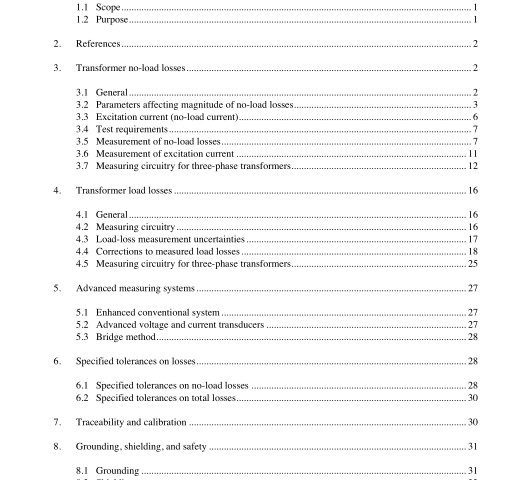IEEE C57.123-2002 pdf download.IEEE Guide for Transformer Loss Measurement
3. Transformer no-load losses
3.1 General No-load losses (also referred to as excitation losses, core losses, and iron losses) are a very small part of the power rating of the transformer, usually less than 1%. However, these losses are essentially constant over the lifetime of the transformer (do not vary with load), and hence they generally represent a sizeable operating expense, especially if energy costs are high. Therefore, accurate measurements are essential in order to evaluate individual transformer performance accurately. No-load losses are the losses in a transformer when it is energized but not supplying load.
They include losses due to magnetization of the core, dielectric losses in the insulation, and winding losses due to the ow of the exciting current and any circulating currents in parallel conductors. Load-tap-changing transformers may use preventive autotransformers, series transformers, or occasionally, both. In most designs the no-load losses of these auxiliary transformers add to the no-load losses of the main transformer when the tap changer is not in the neutral position. For example, the additional no-load losses of preventive autotransformers depend on whether the tap changer is bridging or non-bridging. For series transformers, the additional no- load losses depend on tap position. No-load losses are affected by a number of variables discussed in the following clause.
3.2 Parameters affecting magnitude of no-load losses
3.2.1 Induction Losses in the core vary with the level of induction in the core (ux density), and thus the base no-load loss is established by the rated level of the design core ux density of the transformer.
3.2.2 Excitation voltage magnitude Since the core ux density is a direct function of the magnitude of the excitation voltage, no-load losses are also a function of this voltage, for example, a 1% change in voltage causes a corresponding change in core losses generally in the 1%–3% range. The design and material used for the core determine the magnitude of the change in losses. It is, therefore, essential to have an accurate measurement of the magnitude of the excitation voltage.
3.2.3 Excitation voltage waveform No-load losses are usually quoted and reported based on a sine-wave voltage excitation. Even with a sinusoidal source voltage, the non-linearity of the transformer core introduces signicant harmonics into the excitation current and could result in distorted excitation voltage and ux waveforms. The magnitude of the voltage waveform distortion is usually determined by the output impedance of the voltage source and the magnitude and harmonics of the excitation current. The higher these parameters are, the greater will be the magnitude of the voltage waveform distortion. Figure 1 illustrates the supply transformer circuit at the no- load test.
Figure 2 shows a typical excitation current waveform. Assuming a source impedance of 10%, an excitation current equal to 2% of rated current, and a 50% fth harmonic, the resultant excitation voltage will have approximately a 0.5% fth harmonic.
Measurements will vary markedly with waveform. Peaked voltage waveforms (form factor greater than 1.11) result in lower losses than those of sine-wave voltage. Flat top waves, however, result in higher losses than those for the corresponding pure sine wave. It is, therefore, a requirement to accurately account for the effect of having a distorted waveform.IEEE C57.123 pdf download.IEEE C57.123-2002 pdf download
IEEE C57.123-2002 pdf download

Leave a Reply